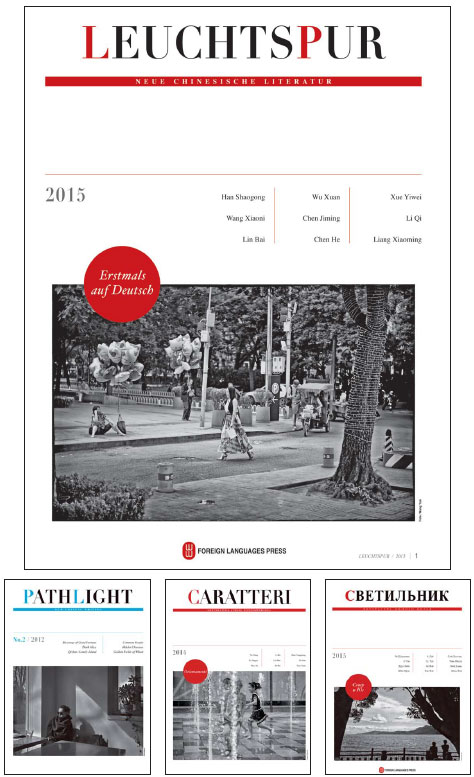Spreading the word
Updated: 2016-01-15 07:44
By Mei Jia(China Daily Europe)
|
|||||||||||
|
|
With new editions in different languages, a Chinese magazine is taking the country's contemporary literature to the world
Son of a robber, a betrayed woman and a lonely boy. When he read stories of these characters in the first German issue of Pathlight magazine, Enrico Brandt, cultural affairs officer at the German embassy in Beijing, says he could feel their pain as they faced society's cruelty.
Launched last month, the first of its kind literary magazine is tailor-made for German readers of today's Chinese literature by the editorial team of the parent Chinese magazine, People's Literature.
Two issues have also been published in French and Italian, and one each in Russian and Japanese. Newer versions are in development in seven additional languages, including Spanish, Arabic and Korean, according to the magazine's editor-in-chief, Shi Zhanjun.
A seminar on the French version is planned in Beijing on Jan 21.
Born soon after the establishment of the People's Republic of China in 1949, People's Literature magazine began as a record of contemporary Chinese literary life, and soon became a cradle that witnessed the birth of generations of renowned writers.
Shi tells China Daily that the multilingual twist of the top Chinese literary magazine was "triggered by the many invitations we got from the countries".
He sees it as a breakthrough when compared with his past experience of having seen translated Chinese novels placed in foreign bookstores under the category of "sociology".
"There was too much misunderstanding. All we want to do through Pathlight is to share with the global audience how ordinary Chinese people nowadays might feel and react toward the world," Shi says, and "that Chinese literature is about good stories and good language."
Shi believes literary exchanges should be an intimate chat with full mutual respect, not deferential pandering by one side to the other.
"When it comes to Chinese literature's global publishing, instead of waiting for the foreign publishers to pick and choose, Pathlight offers another efficient way in which we have the initiative," says Liang Xiaosheng, a writer and professor with Beijing Language and Culture University.
The English version is the first of the series of international editions. Launched in 2011, it's a quarterly that's been redesigned from the cover to the illustrations to suit global tastes.
With no example to follow, Shi says the team has not rushed, but was willing to go back and forth to find whatever worked, even if it meant changing one cover photo over 10 times, until they finally sent someone out to the Sanlitun area of Beijing to capture the perfect moment.
Concentrating on one theme for each issue, it features short stories, novellas and poems by contemporary writers, especially from younger generations.
"The form of a collection of short stories and poems is different than that of a novel. It gives more authors the opportunity to reach foreign readers, and at the same time, gives the readers a better overview of the current literary landscape in China," says Gong Yingxin, director of the German Book Office Beijing of the Frankfurt Book Fair.
To publishing consultant Wang Jing, the key is to have the cross-cultural editorial team work together, combining the strengths of translators, scholars and critics who are either native speakers of English or Chinese.
"Pathlight is lucky to work together with Eric Abrahamsen from the beginning," Wang said at a Beijing Language and Culture University forum last month discussing the magazine's good reception.
Abrahamsen, from the US city of Seattle, is the winner of the 2015 China Special Book Award for his contributions in promoting Chinese literature. He also started a translators' agency, Paper Republic.
"We definitely tend to aim at younger writers, and those with more unique voices. We're not really concerned with the status of the writers inside China, we're mostly just interested in their ability to write," Abrahamsen says, adding that that is where his team sometimes comes into conflict with their Chinese partners.
The editors of both languages pitch themes and select works together, ensuring the final choices have quality and also appeal to the targeted readers.
"The process of editing always takes longer than we expect at the beginning," Gong says, recalling the birth of the first German issue.
The other versions, which are all annual, follow the English edition. Each of them has one Abrahamsen counterpart who is an arbiter of the taste of that audience's readers, according to Shi. For Italian, it's Lisa Carducci; for the Swedish language, it's Anna Gustafsson Chen.
The first German version features 18 writers on the theme of "thinking".
"Thinking of ordinary people in the process of radical social changes - it is about humanity, not necessarily the 'Chineseness' of the characters. I think the readers are very satisfied with the magazine and would like to read more," Gong says.
While counselor Brandt is looking forward to reading more about Chinese women, youngsters and sci-fi from Pathlight, the French version, titled Promesses Litteraires, offers works of only female writers in its debut, and of male writers born after the 1960s for the second issue.
Zhang Wei and a writer of animal stories, Hei He, are featured in the spring issue of the English edition, dedicated to nature.
The magazines are now available at universities, some public libraries and the Confucius Institute worldwide. Shi and the team are also working on online versions.
"I think from the very beginning Pathlight was good as a magazine, but most of the experimentation and adjustment that we've done over the years has been trying to make the magazine more visible, and more accessible," Abrahamsen says.
"I hope it will reach more after gaining recognition first from the professional readers, like reporters, writers and scholars," he adds.
According to the latest data from the State Administration of Press, Publication, Radio, Film and Television, China bought 16,918 overseas copyrights in 2014 while selling 10,171. Exports of publishing copyrights have increased by a factor of 6.5 compared with 10 years ago, striking a better balance. The Pathlight's experience would have been a different story back in the 1980s, when China began publishing translated works on a large scale, and there was little demand for reading on China, says Dai Jinhua, a Peking University professor. "Now with the backdrop of China rising, I think we'll have a series of new stories to tell the world, offering our values and a new perspective of thoughts through our literature and culture," Dai says.
meijia@chinadaily.com.cn
Today's Top News
Chinese firms making inroads in UK
Value addition
IS claims Jakarta attack, targets Indonesia for 1st time
Chinese people most optimistic in global survey
COSCO offers 700m euros for Greece’s Piraeus Port
Istanbul bomber entered Turkey as refugee
Bird flu case confirmed in eastern Scotland
Cosco poised for Piraeus control
Hot Topics
Lunar probe , China growth forecasts, Emission rules get tougher, China seen through 'colored lens', International board,
Editor's Picks

|

|

|

|

|

|







